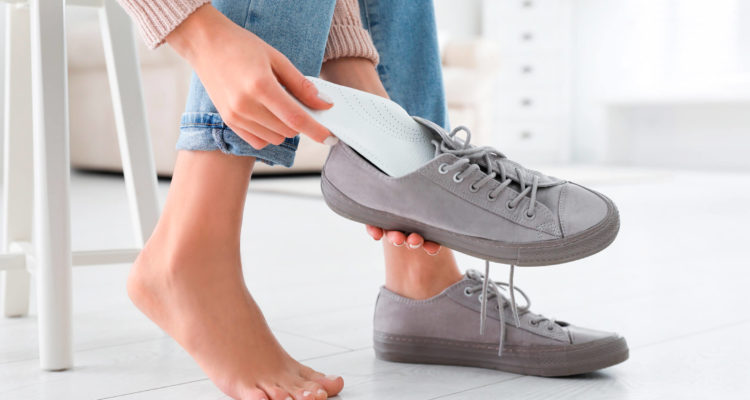
Why do you need orthopedic insoles and how to choose them
0
The best option is to seek help from doctor.
What are orthopedic insoles and why are they needed
Orthopedic insoles are relief inserts for shoes. Not everyone needs them. However, in some cases, the relief of orthopedic insoles plays an important role and can make a person's life significantly easier.
The main task of orthopedic insoles is to provide proper support for the foot. This helps reduce pressure on damaged areas of the sole or correct existing foot abnormalities.
Who needs orthopedic insoles
A classic example of a disorder in which it is desirable to wear orthopedic insoles is flat feet. Normally, part of the foot on the inner side is raised relative to the sole. Orthopedists call this area an arch. It is needed to provide cushioning when walking and running. With flat feet, there is almost no arch. As a result, the cushioning at the feet is bad. And this leads to an increased load on the foot, muscles and joints of the lower limbs.
People with flat feet often feel pain in their feet when walking, complain of aching legs, cramps, changes in gait. In addition, flat feet increase the risk of developing arthritis, bone spurs, bunions and calluses.
Relief orthopedic insoles form the missing arch, supporting the foot in the correct position. This relieves a person of pain when walking and helps reduce the risks of other disorders of the musculoskeletal system.
But flat feet is far from the only example of using orthopedic insoles. Orthopedists list diseases and symptoms in which it makes sense to think about buying insoles. Here they are:
Regular back pain. They can be caused by excessive stress on the spine and core muscles, which occurs due to the wrong position of the foot while walking.
- Pains in the knees.
- Pains in the heel, deformity of the toes, constant bunions.
- Arthritis.
Diabetes. With this disease, people sometimes lose sensitivity in their feet (this condition is known as diabetic neuropathy), which is why they do not always understand that they need to change their posture and reduce the load on their feet. Orthopedic insoles in this case help to reduce excessive pressure on the foot – otherwise it can lead to the formation of calluses and even ulcers on the sole.
Recently injured feet and ankles.
How choose orthopedic insoles
Globally, there are only two options:
- Make insoles to order from an orthopedist.
- Buy ready-made products in a store.
The most competent way is, of course, the first. For the reason that first, the orthopedic specialist will study your symptoms and health complaints in detail, look at your medical history, assess the condition and biomechanics of your feet (how they work and what load they feel when walking or running), make a cast of them or model a project on the computer. Based on the results of the examination and on the basis of a cast or modeling, unique orthopedic insoles will be made for you, which will effectively solve your problem.
But the individual order has a negative price. The cost of orthopedic insoles created for a specific foot can reach 1.5 thousand hryvnias.
It is much easier and cheaper to buy ready-made insoles for shoes. Embossed insoles can be found in pharmacies, shoe stores and even regular supermarkets.
Naturally, they will not fit under your foot. Therefore, experts do not consider such insoles to be orthopedic (no matter how the advertising calls them), and you should not expect special efficiency from them. However, the insoles are attractive due to their low cost and availability. Orthopedists consider them a good trial option: if the problem is small – for example, you are upset by calluses that regularly appear or fatigue in your feet, you can first experiment with store inserts.
If you decide to stop at this option, make a purchase consciously. This is what the specialists of the American Orthopedic Medical Association recommend.
Be sure to “try on” the insole
In the sense, try to install it in the shoes in which you plan to use it . If the insole fits like a glove, this is a good option. If you cannot install it (for example, the liner has to be bent, or it does not completely cover the inner surface of the shoe), such a lining will be ineffective.
Remember the purpose for which you need an insole
If you want to get rid of calluses, diabetic ulcers or prevent their appearance, you need to choose so-called accommodation insoles – they are made of soft cushioning material. If your goal is to correct flat feet or other features of the foot, you will need rigid functional products: their relief should really support the foot, and not bend under your weight.
There is an easy way to determine what your chosen liner is for. If you can easily bend the insole at any point, it is an accommodation option. It will not cope with foot support.
Try the insole
This is not always possible. However, if the store allows you to install an insole in the shoe and walk in it, be sure to use it and take a couple of steps. You should be comfortable. Even the slightest pressure or discomfort is a sure sign that the insole does not fit.
Don't chase cheapness
The cheaper the insole, the higher the risk that already after a few days, inexpensive memory foam, EVA, silicone, gel or other fillers will sag under your weight. In this way, the insole will lose its cushioning properties, and you will have to buy a new one.
For comparison: the service life of orthopedic insoles made to order reaches 2-3 years. So, in the long run, individual, truly orthopedic insoles may turn out to be a more economical option than cheap store-bought ones.









Leave a Reply